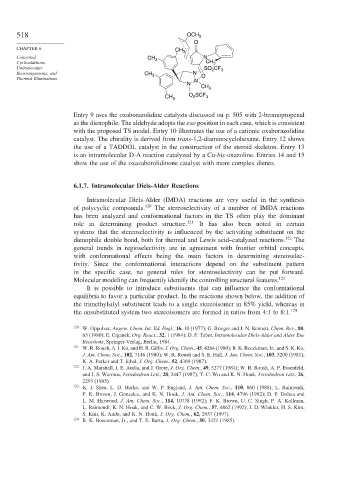Page 544 - Advanced Organic Chemistry Part B - Reactions & Synthesis
P. 544
518 OCH 3
O
CHAPTER 6 CH 3
Concerted CH 3 N
Cycloadditions, CH 3
Unimolecular SO CF 3
2
Rearrangements, and CH 3 N
Thermal Eliminations Al O
N
CH 3
O SCF
CH 3 2 3
Entry 9 uses the oxaborazolidine catalysts discussed on p. 505 with 2-bromopropenal
as the dienophile. The aldehyde adopts the exo position in each case, which is consistent
with the proposed TS model. Entry 10 illustrates the use of a cationic oxaborazolidine
catalyst. The chirality is derived from trans-1,2-diaminocyclohexane. Entry 12 shows
the use of a TADDOL catalyst in the construction of the steroid skeleton. Entry 13
is an intramolecular D-A reaction catalyzed by a Cu-bis-oxazoline. Entries 14 and 15
show the use of the oxazaborolidinone catalyst with more complex dienes.
6.1.7. Intramolecular Diels-Alder Reactions
Intramolecular Diels-Alder (IMDA) reactions are very useful in the synthesis
of polycyclic compounds. 120 The stereoselectivity of a number of IMDA reactions
has been analyzed and conformational factors in the TS often play the dominant
role in determining product structure. 121 It has also been noted in certain
systems that the stereoselectivity is influenced by the activating substituent on the
dienophile double bond, both for thermal and Lewis acid–catalyzed reactions. 122 The
general trends in regioselectivity are in agreement with frontier orbital concepts,
with conformational effects being the main factors in determining stereoselec-
tivity. Since the conformational interactions depend on the substituent pattern
in the specific case, no general rules for stereoselectivity can be put forward.
Molecular modeling can frequently identify the controlling structural features. 123
It is possible to introduce substituents that can influence the conformational
equilibria to favor a particular product. In the reactions shown below, the addition of
the trimethylsilyl substituent leads to a single stereoisomer in 85% yield, whereas in
the unsubstituted system two stereoisomers are formed in ratios from 4:1 to 8:1. 124
120
W. Oppolzer, Angew. Chem. Int. Ed. Engl., 16, 10 (1977); G. Brieger and J. N. Bennett, Chem. Rev., 80,
63 (1980); E. Ciganek, Org. React., 32, 1 (1984); D. F. Taber, Intramolecular Diels-Alder and Alder Ene
Reactions, Springer-Verlag, Berlin, 1984.
121 W. R. Roush, A. I. Ko, and H. R. Gillis, J. Org. Chem., 45, 4264 (1980); R. K. Boeckman, Jr., and S. K. Ko,
J. Am. Chem. Soc., 102, 7146 (1980); W. R. Roush and S. E. Hall, J. Am. Chem. Soc., 103, 5200 (1981);
K. A. Parker and T. Iqbal, J. Org. Chem., 52, 4369 (1987).
122
J. A. Marshall, J. E. Audia, and J. Grote, J. Org. Chem., 49, 5277 (1984); W. R. Roush, A. P. Essenfeld,
and J. S. Warmus, Tetrahedron Lett., 28, 2447 (1987); T.-C. Wu and K. N. Houk, Tetrahedron Lett., 26,
2293 (1985).
123 K. J. Shea, L. D. Burke, and W. P. England, J. Am. Chem. Soc., 110, 860 (1988); L. Raimondi,
F. K. Brown, J. Gonzalez, and K. N. Houk, J. Am. Chem. Soc., 114, 4796 (1992); D. P. Dolata and
L. M. Harwood, J. Am. Chem. Soc., 114, 10738 (1992); F. K. Brown, U. C. Singh, P. A. Kollman,
L. Raimondi, K. N. Houk, and C. W. Bock, J. Org. Chem., 57, 4862 (1992); J. D. Winkler, H. S. Kim,
S. Kim, K. Ando, and K. N. Houk, J. Org. Chem., 62, 2957 (1997).
124
R. K. Boeckman, Jr., and T. E. Barta, J. Org. Chem., 50, 3421 (1985).

